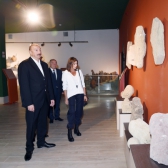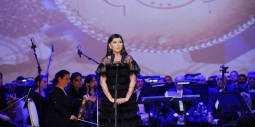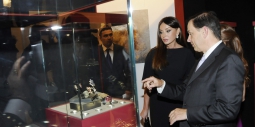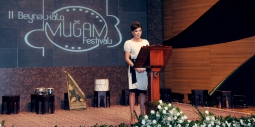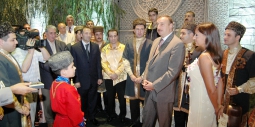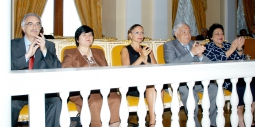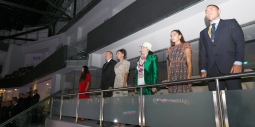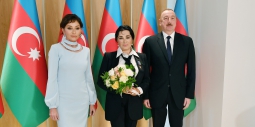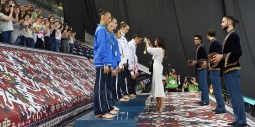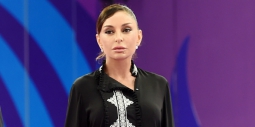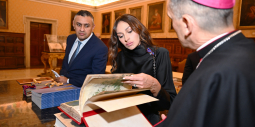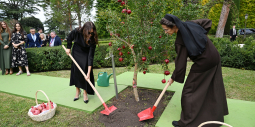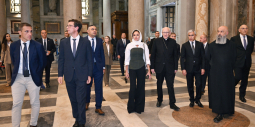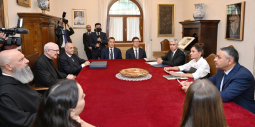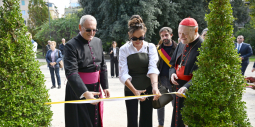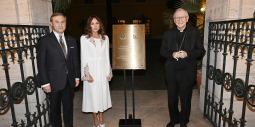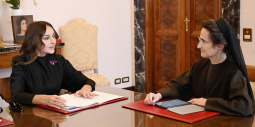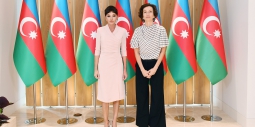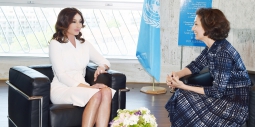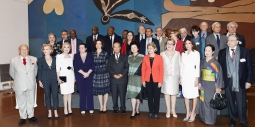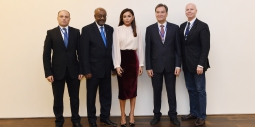Inauguration of the Demirchi Archaeological Museum constructed in Shamakhy following the Heydar Aliyev Foundation’s initiative takes place
26.08.2018President of the Republic of Azerbaijan Ilham Aliyev and First Lady Mehriban Aliyeva attended the inauguration of the Demirchi Archaeological Museum constructed in Shamakhy district following the Heydar Aliyev Foundation’s initiative.
According to the information provided, the history of Demirchi, one of the oldest villages of Shamakhy, dates back to the 15th century. Blacksmith families coming from Ahan village of Ismailli district had settled here temporarily, then on a permanent basis. Due to the residents’ occupation, the village was later renamed, to become Demirchi. Located 1500 metres above the sea level, this village has a mild climate, with cool summer. A truism infrastructure, including a blacksmith and coppersmith workshops, cafe, teashop, tandir, corner of “Azerkhalcha”, souvenir shop, “ABAD” shops and a car parking lot have been created in the centre of the village, and “Gala” and a spring complex were built. Following the President’s instruction, the village mosque, one of the oldest religious temples of our country, was renovated. President Ilham Aliyev and First Lady Mehriban Aliyeva, in the framework of their visit to Demirchi village in October last year, became familiarized with the condition of the mosque after the reconstruction, and the tourism infrastructure created here.
Becoming acquainted with the conditions created in the museum, President Ilham Aliyev and First Lady Mehriban Aliyeva were informed that construction of the museum building started in February this year. High level construction works were finished in August. The one-storey building is comprised of open and closed exposition halls, and two secondary rooms. An open museum here draws attention particularly.
While building the Demirchi-Lahyj road, necropolis related to late antic and early Middle Ages has been discovered in a three-hectare area on the territory called Gadali table, 4 kilometres off the village. Up to 30 stone box graves, fortress walls and underground storehouses have been discovered during the research works, about 50 to 80 centimetres from the surface. Walls of all the square-shaped graves have been built from rocks containing river stones and lime stones, with the top being covered with stone slabs. Skeletons in the graves were discovered in a wrapped position on the left side, with the head looking mainly in the north-east direction. Sufficient amount of rich material and cultural examples related to the Albanian era have been found in the box graves. Among the findings, earthenware and china products predominate by their numbers. Metal examples, including arms and knifes, as well as bronze adornment items are seen more often in stone box graves. In some graves, a silver cup was found under the skeleton’s head. One of the most important finding in scientific term was fabric remnants in the cup under the head, which is considered to be the oldest example of fabric found on the Azerbaijani territory during archaeological excavations. In one of the graves, there were a sword and a dagger next to the skeleton. These findings give us grounds to assume that that grave belonged to a warlord or at least a military man enjoying special respect among people.
In general, 7 sections have been created in the museum’s exhibition hall. Here are displayed material and cultural examples found during the archaeological excavations in Shamakhy district, as well as Demirchi village, with rare stone tools, labour tools related to farming culture, cold weapons, copper, bronze and silver coins, water pipes made of stone, ancient clayey products and other valuable findings, and household items. These exhibits will arouse great interest in tourists visiting this museum, giving them a chance to become closely acquainted with the history of our country. The museum is of significance also in terms of studying various periods of the district’s history.



